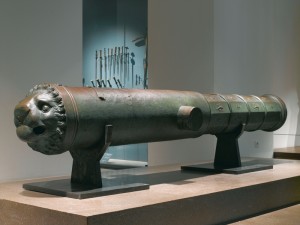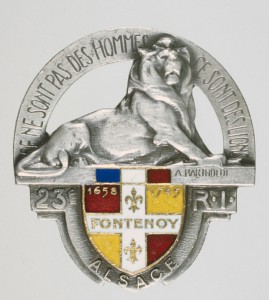Founded for the Hospitallers of the Order of St. John of Jerusalem, this canon comes from the island of Rhodes and was offered to Napoleon III by the Sultan Abdul-Aziz, in 1862. It is on exhibit in the Department of Ancient Arms and Armour of the Musée de l’Armée.
“The empire needs men! The overseas states all answer the call. Helped by the young lions, the old lion defies his foes. Enlist now”. WWI recruitment poster by animal painter Arthur Wardle (1860-1949), printed by Straker Brothers Ltd, London. Publisher: Parliamentary Recruiting Committee, London 1915. From the outset, the lion has always incarnated strength and valour. The dexter supporter of the royal coat of arms of the United Kingdom is a crowned English lion, the sinister a Scottish unicorn and the crest a statant guardant lion wearing the St Edwards Crown. From the outbreak of the Second World War to his death, Winston Churchill was referred to as the “Old Lion” by the British people. © Paris, musée de l’Armée Dist. RMN-GP / Pascal Segrette
Insignia of the 23rd Infantry Regiment featuring the celebrated monumental statue of the Belfort lion executed by French sculptor Frederic-Auguste Bartholdi between 1875 and 1879, and of which a smaller bronze replica stands in the middle of the square of Place Denfert-Rochereau in Paris. The motto of the 23rd Infantry Regiment is “They are not men, they are lions”. This regiment was created in 1644 and nicknamed the “Regiment of lions” following its participation in the Battle of Fontenoy in 1745. Its shield bears the colours of the Royal Regiment, the regiment’s name prior to 1791. The regiment was disbanded in 1976. © Paris, musée de l’Armée, Dist. RMN-GP / Pascal Segrette
The lion
From Egypt to Rome
Although the lion does not fight alongside the soldiers, his image is extremely present on the battlefields. He is reputed to be powerful, courageous and generous. These qualities can only inspire the warrior who sees in him an ideal. This is the reason why his image has been present and revered in all cultures at all times.
In the ancient world, the lion was popularly known, thanks to the royal menageries and the circus games. His valour inspired the Egyptians who represented him on a pendant that was presented as a reward to officers for outstanding and valiant actions. The image of the lion was associated with the power of Pharaoh. Receiving such an honour was very rare and only four awards of this type have been discovered by archaeologists up until now.
The Romans were also inspired by the image of the lion. They used to wear animal skins during the fighting and the veterans of the Roman Army choose the symbol of the lion on their gravestones.
A Powerful Symbol
Besides this pagan imagery, the lion also has a strong symbolic Christian value since it incarnates Mark the Evangelist in the Tetramorph. The lion is frequently quoted in the Old Testament and in the New Testament where the metaphoric image of Christ is associated with the Lion of Judah. The lion appears later in the lives of the Saints and the Martyrs of Christendom. Its breath is a symbol of resurrection.
Because of his power, the lion has been chosen as the emblem of aristocratic and royal families. He appears on the coat of arms of knights and sovereigns but also of states. Richard I of England (1157-1199) is even known in France under the name of “Richard the Lionheart”. This tradition still persists in the army where the lion can be found on the insignia and the mottos of several French regiments.
More recently and outside Europe, during the Soviet-Afghan War (1979-1989) Ahmad Shah Massoud earned the nickname of “Lion of Panjshir” after repelling seven major Soviet attacks in the Panjshir Valley.





Ajouter un commentaire